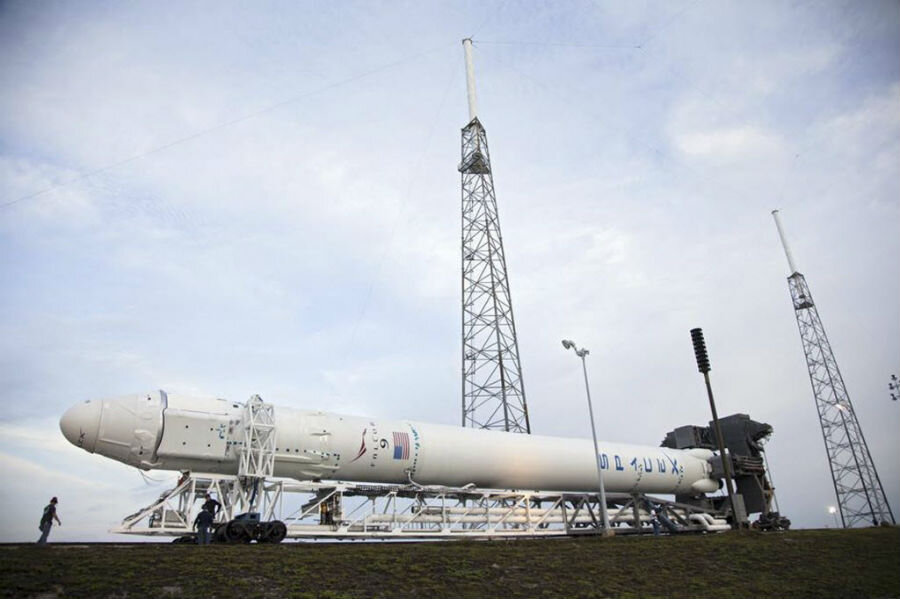SpaceX sets ambitious itinerary for 2015: Can it deliver?
Loading...
If you want to peek at an ambitious list of spaceflight-related activities for the new year, take a look at some of Space Exploration Technologies Corp.'s objectives:
- Saturday morning's rescheduled launch of cargo to the station includes a test landing of the first stage of the company's Falcon 9 rocket on a solid surface – a football-field-scale floating landing pad, with the ungainly name of autonomous spaceport drone ship. One of the company's goals is to drive down launch costs by fielding a fully-reusable rocket with a short turn-around time between launches.
- Under NASA's commercial-crew program SpaceX's Dragon capsule faces two crucial tests of its launch-abort system in anticipation of carrying crews to and from the space station.
- The company's Falcon Heavy is expected to undergo its first test flight in the third quarter of this year. The rocket uses three Falcon 9 first stages, strapped side by side, with a second stage and payload topping the stage in the center of the pack. The rocket's ability to loft heavy payloads to low-Earth orbit will be comparable to NASA's late lamented Saturn V rocket, which sent astronauts to the moon.
- SpaceX is expected to complete its efforts to earn US Air Force certification to compete for launches of some of the nation's largest, most sophisticated military satellites.
- The company is working on a Mars Colonial Transporter system as well as new designs for space suits that "look like a 21st century space suit and work really well," wrote Elon Musk, SpaceX's founder, chief executive officer, and chief technology officer, during an on-line question and answer session on the online forum Reddit earlier this week. He said he hoped to present the architecture for the Mars transportation system and unveil the new suit design by the end of the year.
And that's all addition to successfully launching satellites for customers and making cargo runs to and from the International Space Station for NASA.
The list of to-dos highlights the remarkable progress the 12-year-old, started-from-scratch company has made since its first successful rocket launch in 2009, involving its first model, the Falcon 1.
It's a pace of development and growth that turns heads among some observers.
"In a relatively short period of time, SpaceX has made historic progress as a launch provider and helped prove how effective competition can be in the civil space industry," said Lt. Gen. Samuel Greaves, commander of the US Air Force's Space and Missile Systems Center in El Segundo, Calif., in a statement noting the progress the company has made in achieving Air Force certification.
On one level, the statement could be read as an attempt to soften the news that SpaceX, based in neighboring Hawthorne, hadn't quite cleared the certification hurdles by the end of 2014, as previously hoped. On another level, however, it's an testament to how quickly the company has grown to be an increasingly influential force in the space-launch business.
SpaceX has been aggressive in fielding new families of more-capable rockets and taking steps to show reusable rockets don't need to look like airplanes, according to Lance Erickson, a professor and program coordinator for commercial space operations at Embry-Riddle Aeronautical University in Daytona Beach, Fla.
"They haven't been perfectly successful," he says, "but they haven't had any major mistakes along the way."
Several factors have contributed to the company's success so far, analysts say, not the least of which is Mr. Musk's vision-driven approach as founder and CEO. He says that for the human species to survive, it must become a multi-planet species and so is working toward that goal.
Moreover, his sense of timing helped. He founded SpaceX in 2002, as the country was reeling from the loss of the space shuttle Columbia and its seven-member crew but also had developed a wealth of rocketry talent, some of whom were attracted to the idea of working for a privately owned spaceflight start-up, rather than the more established launch providers or for NASA.
The company had its teething problems. Between March 2006 and August 2008, it endured three failures of its Falcon 1 rocket. By the end of September, SpaceX posted its first launch success and launched one additional Falcon 1 successfully before shifting payloads to its new Falcon 9. First launched in 2010, that rocket – a nine-motor-version of the Falcon 1 – has had 13 successful launches, although it failed to deliver one satellite to orbit as a secondary payload to an otherwise successful space-station cargo mission.
To be sure, the company has benefited financially as well as technologically from its cargo and commercial-crew agreements with NASA, notes Micah Walter-Range, who tracks trends in the aerospace industry for the Space Foundation, a spaceflight-advocacy organization based in Colorado Springs, Colo. And it's knocking on the door to compete for big-budget defense payloads.
"But the genesis of that whole family" of rockets "was an independent venture," Mr. Walter-Range says.
"You have a company that was built from the very beginning to design things quickly and to figure things out as quickly as possible," he says.
It's a trait typical of high-tech start-ups, he continues, adding, "when you have that start-up, get as far as you possibly can before it loses the agility that comes with being a start-up."
A penchant for thinking ahead as SpaceX designs its vehicles helps as well – designing its Dragon capsule from the outset with human passengers in mind, even as the craft initially serves as a cargo craft, for instance.
With Saturday's scheduled launch from the Cape Canaveral Air Force Station at 4:47 a.m. ET, the company is striving for a successful cargo mission even as it raises the bar in testing its first stage landing system.
Perhaps it's another test as well: one that focuses on a start-up's agility and ability to move at the speed of ideas.






